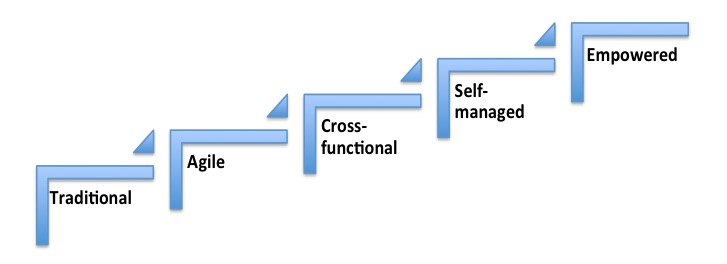In almost every meeting that I have these days, the notion of organizational change comes up. Everyone is concerned with changing too slow and the risk of being disrupted by more agile and innovative competitors they haven’t even heard of. My role gives me the opportunity to talk to people at all levels in typical organizations, ranging from front line engineers to C-suite executives. Interestingly, everyone complains about the same thing: they want to change, but they can’t get the rest of the organization with them. Front line engineers are waiting for manager approval to change things and senior leaders complain that they can’t get the rest of the organization to “follow” them. The result is that we end up in organizational deadlock: everyone is waiting for everyone else to make the first step.
For the last decades, organizations have focused on operational efficiency. To achieve this, the focus was on building deeply interconnected organizational architectures where every function and team is dependent on other functions and teams and delivers to others. The analogy is that of a finely tuned machine where all the cogs and gears fit as closely together as possible. This works great as long as the organization is in a predictable and stable business environment. However, two things have happened: first, all work, blue-collar and white-collar, that is repeatable is being automated. For years, the focus of IT was to support people in doing their job more efficiently. Now the focus has shifted to automating the job completely. Second, companies no longer operate in stable environments, but rather in highly unpredictable environments where the risk of disruption has never been higher.
The fundamental business operating system of the last decades of building the highly integrated organizations that are highly optimized for one purpose and are not much use for anything else is what is causing the organizational deadlock that many organizations experience. Sadly, this operating mechanism not only affects industry. It as much, if not more so, affects government institutions. These institutes are even more driven by rules and regulations that are intended to ensure consistency and fairness, but in the process disempower and alienate their employees who chose their jobs, and frequently the associated lower salary, out of a desire to contribute to society.
One of the people that I talked to this week reminded me of this: it is the “big five” management consulting firms that share a lot of responsibility for large, traditionally successful organizations to end up in this place. These were the ones asked by C-level executives for advice (similar to buying from IBM in the 1980s) in an attempt to reduce their own responsibility by adhering to industry best practices. Clearly, relying on the “big five” to get us out of this mess is a really bad idea – we need inspiration from elsewhere.
One “knee-jerk” reaction that several people and organizations look for is a strong leader. This strong leader is then expected to set a strategy, cut through the organizational deadlock and get everyone aligned around one direction. The logical consequence of that strategy is that this “strong leader” also gets the power and authority to decide and overrule everyone. And of course, in this approach, dissenting voices are not allowed and shut down aggressively. We see this in politics as well as in many companies, but, to paraphrase Albert Einstein, for every problem, there is a solution that is simple, elegant and wrong.

Figure: The strong leader does not allow for dissent
Centralizing power and relying on a strong leader is wrong at two levels. First, it puts the fate of the organization (or even a country) in the hands of a single individual and assumes that this person will be right in the direction that he or she sets. Consequently, it does not make use of the collective intelligence of the organization. Second, it’s “the easy way out” for everyone else. By abdicating power to the strong leader, everyone else feels that they have no responsibility for the future success of the organization. So they can just lean back and wait for their marching orders.
In my experience, the right direction is the exact opposite of centralization. The reason for organization deadlock is that everyone is waiting for permission from elsewhere. So, the central theme of a new business operating mechanism has to be empowerment of individuals and teams. This gives not only authority but also an expectation to decide, experiment and act to teams and individuals. This does not mean that every team will be successful. In all likelihood, the majority of things that are tried will not be successful. But the fact is that rather than running one experiment, set by the “strong leader” and betting the company on its success, we’re running hundreds or even thousands of small experiments, learn and find a direction forward that helps the company transition to a successful future.
We need a new business operating mechanism that is based on, at least, these three principles:
- Empowerment: First, everyone in the company needs to be empowered to make decisions based on their best understanding without having to ask for permission. This is a critical element as the very act of having to ask for permission already reduces or removes initiative. In addition, hierarchical organizations are notoriously slow in decision making, especially when things need to go up and down the line and we can’t afford these delays.
- Data-driven decision making: The organization needs a much higher level of transparency and access to data should be free for everyone. Members of the organization want to make good decisions and one important ingredient is access to information.
- Relentless innovation: Finally, the focus of everyone should be relentless innovation in all aspects of the products, solutions and services, but also internal processes and ecosystem engagements. Of course, all these innovation efforts should be data-driven so that there is as quick feedback as possible as to what is successful. Repetitive work should be aggressively automated as humans are too expensive and quite poor at boring work.
Transitioning to this model can not be done in one step, so we developed a model to move towards this new business operating mechanism in an iterative fashion. As shown in the figure below, we view agile practices as the first step where teams get autonomy. This sets the direction for allowing for increasing empowerment in larger and larger sections of the organization.

Figure: Five steps to become an empowered organization
So, let me know what you think! How do we move beyond organizational deadlock?